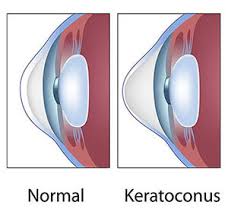What is it?
 Keratoconus, often abbreviated as “KC”, is a non-inflammatory eye condition that causes continuous thinning and alteration of the cornea, often to a cone size shape. Over time, the progression of the disease can lead to vision loss necessitating a corneal transplantation. The cornea is the clear window of the eye and is responsible for refracting most of the light coming into the eye. Therefore, abnormalities of the cornea severely affect the way we see the world, making simple tasks, like driving, watching TV or reading a book difficult.
Keratoconus, often abbreviated as “KC”, is a non-inflammatory eye condition that causes continuous thinning and alteration of the cornea, often to a cone size shape. Over time, the progression of the disease can lead to vision loss necessitating a corneal transplantation. The cornea is the clear window of the eye and is responsible for refracting most of the light coming into the eye. Therefore, abnormalities of the cornea severely affect the way we see the world, making simple tasks, like driving, watching TV or reading a book difficult.
In its earliest stages, keratoconus causes slight blurring, distortion of vision, and increased sensitivity to glare and light. These symptoms usually first appear in the late teens and early twenties. Keratoconus may progress for 10-20 years and then slow or stabilize. Each eye may be affected differently.
Eyeglasses or soft contact lenses may be used to correct the mild nearsightedness and astigmatism caused in the early stages of keratoconus. As the disorder progresses and the cornea continues to thin and change shape, rigid gas permeable contact lenses are generally prescribed to correct vision more adequately. The contact lenses must be carefully fitted and frequent checkups and lens changes may be needed to achieve and maintain good vision. In severe cases, a corneal transplant may be needed due to scarring, extreme thinning or contact lens intolerance. This surgical procedure is necessary in approximately 15-20% of cases. In this surgery, much of the central cornea of the patient is removed and is replaced with the healthy tissue of a recently deceased person.
It is not a common eye disease, but it is by no means rare. It has been estimated to occur in 1 out of every 2,000 persons in the general population. It is found in all parts of the United States and the rest of the world. It has no known significant geographic, cultural or social pattern. In the earliest stages of KC, ordinary eyeglasses or soft contact lenses may correct the mild myopia (near-sightedness) and astigmatism that is experienced. Ultimately Rigid Gas Permeable (RGP) contact lenses are needed to correct vision. These lenses are specially designed for keratoconus. There is not one “best” lens for KC, the best lens is one that fits without damaging the cornea, provides the best vision, wear time, and comfort. Technological advances in both gas-permeable and soft lenses offer more possibilities for those with keratoconus to achieve clear, comfortable vision.
Is it treatable?
Boston Eye Group now offers the latest revolutionary treatments for Keratoconus: Intacs surgery and collagen cross-linking .One option, Intacs surgery, is a treatment where plastic rings are inserted into the mid layer of the cornea to flatten it, changing the shape and location of the cone. This can slightly improve uncorrected vision, but depending on the severity of the Keratoconus, may still require contact lenses for functional vision. Intacs received FDA approval for keratoconus in August 2004.
Cross-linking is the newest proven procedure that allows stiffening of the collagen in the cornea to prevent further deterioration of keratoconus. The treatment consists of the application of Riboflavin, a vitamin, to the cornea. This, combined with UV light, leads to the stiffening of the collagen fibers which in turn strengthens the cornea to slow the progression of keratoconus. The earlier the procedure is performed, the more effective the results are. Cross-Linking was approved in April 2016. Boston Eye Group is currently one of two practices in Massachusetts to offer this procedure.
For more information on Intacs surgery or cross-linking for keratoconus, or to see if you qualify for one of these innovative treatments, please contact Boston Eye Group directly at (617) 618-5314.
